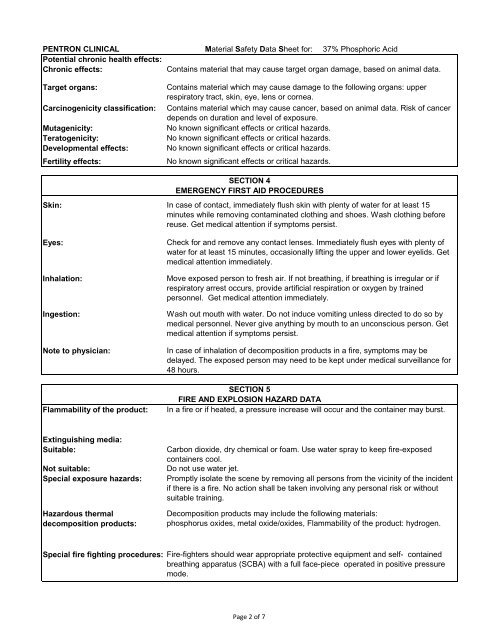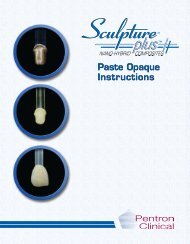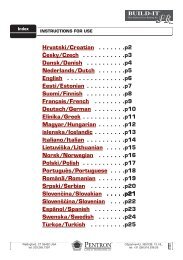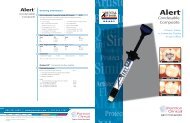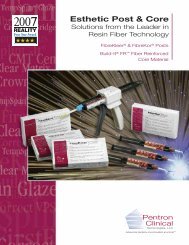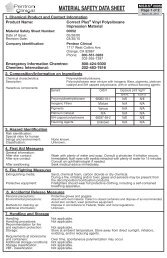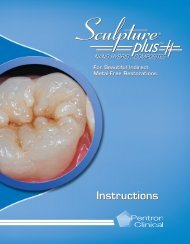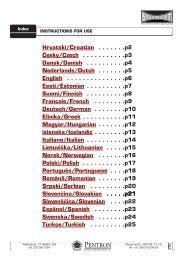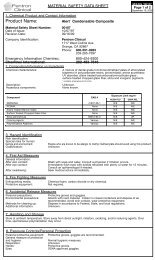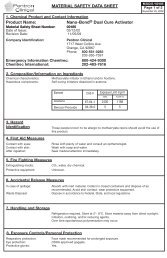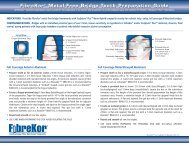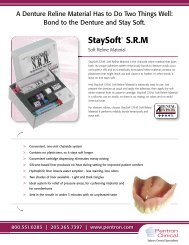37% Phosphoric Acid Etch Gel MSDS - Pentron Clinical
37% Phosphoric Acid Etch Gel MSDS - Pentron Clinical
37% Phosphoric Acid Etch Gel MSDS - Pentron Clinical
You also want an ePaper? Increase the reach of your titles
YUMPU automatically turns print PDFs into web optimized ePapers that Google loves.
PENTRON CLINICAL Material Safety Data Sheet for: <strong>37%</strong> <strong>Phosphoric</strong> <strong>Acid</strong><br />
Potential chronic health effects:<br />
Chronic effects:<br />
Contains material that may cause target organ damage, based on animal data.<br />
Target organs:<br />
Carcinogenicity classification:<br />
Mutagenicity:<br />
Teratogenicity:<br />
Developmental effects:<br />
Fertility effects:<br />
Skin:<br />
Eyes:<br />
Inhalation:<br />
Ingestion:<br />
Note to physician:<br />
Flammability of the product:<br />
Contains material which may cause damage to the following organs: upper<br />
respiratory tract, skin, eye, lens or cornea.<br />
Contains material which may cause cancer, based on animal data. Risk of cancer<br />
depends on duration and level of exposure.<br />
No known significant effects or critical hazards.<br />
No known significant effects or critical hazards.<br />
No known significant effects or critical hazards.<br />
No known significant effects or critical hazards.<br />
SECTION 4<br />
EMERGENCY FIRST AID PROCEDURES<br />
In case of contact, immediately flush skin with plenty of water for at least 15<br />
minutes while removing contaminated clothing and shoes. Wash clothing before<br />
reuse. Get medical attention if symptoms persist.<br />
Check for and remove any contact lenses. Immediately flush eyes with plenty of<br />
water for at least 15 minutes, occasionally lifting the upper and lower eyelids. Get<br />
medical attention immediately.<br />
Move exposed person to fresh air. If not breathing, if breathing is irregular or if<br />
respiratory arrest occurs, provide artificial respiration or oxygen by trained<br />
personnel. Get medical attention immediately.<br />
Wash out mouth with water. Do not induce vomiting unless directed to do so by<br />
medical personnel. Never give anything by mouth to an unconscious person. Get<br />
medical attention if symptoms persist.<br />
In case of inhalation of decomposition products in a fire, symptoms may be<br />
delayed. The exposed person may need to be kept under medical surveillance for<br />
48 hours.<br />
SECTION 5<br />
FIRE AND EXPLOSION HAZARD DATA<br />
In a fire or if heated, a pressure increase will occur and the container may burst.<br />
Extinguishing media:<br />
Suitable:<br />
Not suitable:<br />
Special exposure hazards:<br />
Hazardous thermal<br />
decomposition products:<br />
Carbon dioxide, dry chemical or foam. Use water spray to keep fire-exposed<br />
containers cool.<br />
Do not use water jet.<br />
Promptly isolate the scene by removing all persons from the vicinity of the incident<br />
if there is a fire. No action shall be taken involving any personal risk or without<br />
suitable training.<br />
Decomposition products may include the following materials:<br />
phosphorus oxides, metal oxide/oxides, Flammability of the product: hydrogen.<br />
Special fire fighting procedures:<br />
Fire-fighters should wear appropriate protective equipment and self- contained<br />
breathing apparatus (SCBA) with a full face-piece operated in positive pressure<br />
mode.<br />
Page 2 of 7


